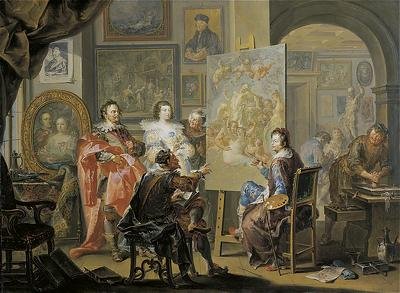
Baccio della Porta was nicknamed as such due to his house being near the Porta (“Gate”) San Pier Gattolini. He would be later known as Fra Bartolomeo. He was born in Savignano di Prato, a town in Tuscany in 1472. As a teenager he worked in the workshop of Cosimo Rosselli, the Florentine painter. Besides being a gifted artist and one of the most accomplished painters of the Italian Renaissance, Fra Bartolomeo was a very religious man and it was said that he spent as many hours praying as he did painting. The Renaissance scholar John Van Dyke even went further calling him a religionist, a person addicted to religion in other words, a religious zealot.
During his late twenties Fra Bartolomeo became a follower of Girolamo Savonarola the fierce and passionate Dominican friar, who vehemently preached against the moral corruption of much of the clergy at the time. He arrived in Florence in 1481 having been sent there by his order in Bologna to “go out and preach”. Initially his sermons were met with little enthusiasm but over time his following grew. By 1491, Savonarola stood before massive crowds with a fiery and fervent enthusiasm. He spoke to the masses and what he told them quickly earned him massive influence over all who heard him. By this time printing had been introduced in Florence and Savonarola was one of the first figures to use printing to spread political and religious propaganda. It was not just the common peasant but artists, writers and members of the aristocracy who listened to this great orator and was swayed by what he preached. For many, he was a prophet and what he uttered were words which came directly from God. Savonarola loathed some of the religious art of the time with its eroticized Virgin Marys and the smirking putti such as could be seen in the works of Raphael. Savonarola was opposed to the humanist trend which had become popular. He hated poetry, literature, perfume, non religious art or anything that was vaguely “fun”. Savonarola once stated:
“They have built up a new Church after their own patter. Go to Rome and see! In the mansions of the great prelates there is no concern save for poetry and the oratorical art. Go thither and see!”
He persuaded painters and their patrons to burn and destroy all artworks that did not conform to his strict code of morality. This edict was listened to by many and the result was that thousands of the greatest Florentine masterpieces ever created by some of the giants of renaissance art were tossed into his notorious Bonfire of the Vanities in February 1497.
In 1492 the death of two of the most powerful men of the time and sworn enemies of Savonarola died within three months of each other. In April, Lorenzo de Medici, the ruler of Florence and once patron of Savonarola died and in July that same year came the death of Pope Innocent VIII. This immediately caused a power vacuum and in 1494 after Charles VIII of France invaded Florence and overthrew the Medicis, Savonarola emerged as the new ruler of the city of Florence. His rule was one of total morality and he criminalized gambling and the wearing of decadent clothing. For him the epidemic of syphilis, which was a growing scourge on the country, was God’s way of punishing the sexual transgressors and he condemned homosexuals and adulterers to death.
At the beginning Savonarola had the majority of the populace on his side and he became even more powerful but slowly and surely the Florentine people tired of his religious zeal and his ever more puritanical laws. His laws were also beginning to affect trade and the once prosperous Florence was having financial difficulties. Things became worse for Savonarola who on May 13, 1497, was excommunicated by Pope Alexander VI and the next year, 1498, Pope Alexander demanded his arrest and execution. A crowd attacked the Convent of San Marco and Savonarola was captured. He was charged with heresy, uttering false prophecies and sedition. He was tortured for several days but would never renounce his words. He stood trial, was found guilty and hung from a high cross and burnt alive. His era was over and shortly afterwards normal Florentine life returned with the artists and Florentine art once again flourishing.
Fra Bartolomeo painted Portrait of Savonarola just before the Dominican friar was executed in 1498. The head and shoulder portrait of the hooded monk is painted against a black background. His unwavering look is stern and one feels that this was a man who held views, the dilution of which he would not countenance. The portrait lacks any human warmth and for that reason one must believe that it is not only a good physical likeness but one which encapsulates Savonarola’s mental state. The Latin inscription on the panel below the portrait proves that the monk was considered to be a prophet:
“Portrait of the prophet Jerome of Ferrara, sent by God.”
The twenty-six year old Baccio della Porta was greatly distressed by the execution of Savonarola and two years later in 1500 he gave up painting all together and took his monastic vows and assumed the name Fra Bartolomeo. He moved into the convent of Saint Marco in Florence. It was not until 1504, with the authorization of the prior, did he resume painting and he dedicated the rest of his life to painting religious studies. By 1508, Leonardo da Vinci, Raphael and Michelangelo had all left the city of Florence and Fra Bartolomeo became the leading painter of Florence.

















